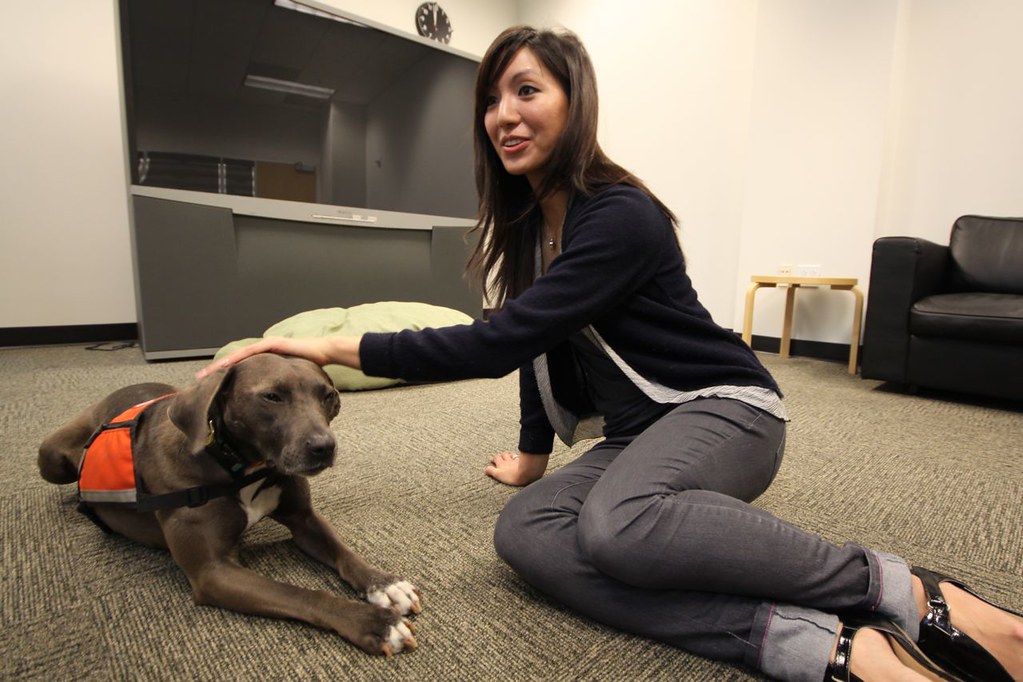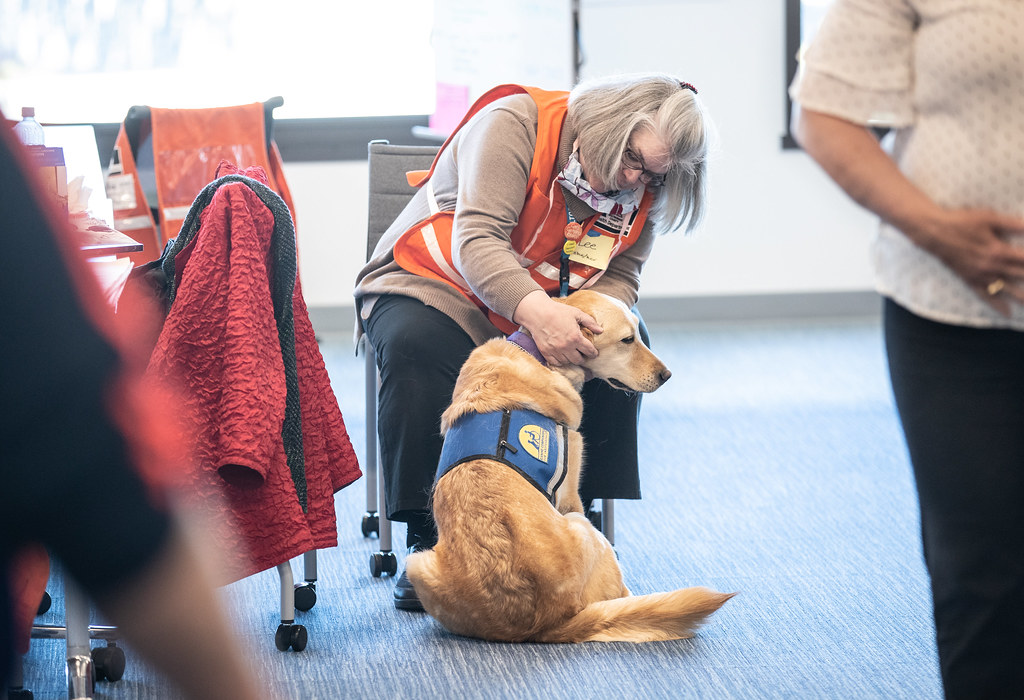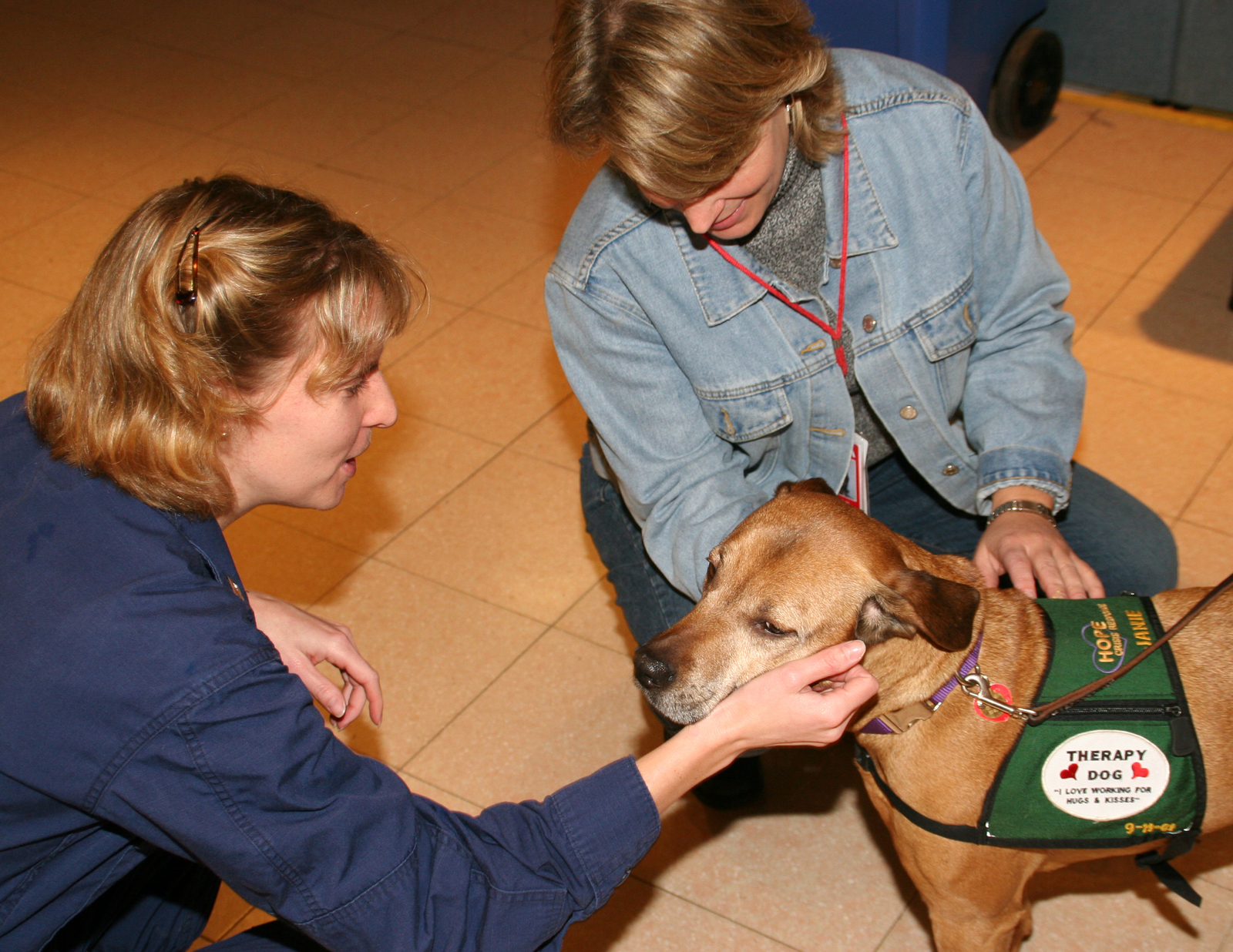Pet therapy uses certified animals to provide mental, physical, and emotional support. Providing love and affection is what these animals are trained to do daily. Felines and canines are the most popular used animals. However, horses, dolphins, guinea pigs, and fish are of great help.
To better understand pet therapy and its importance, I have compiled a list of pet therapy statistics and some of the frequently asked questions.
Benefits Of Pet Therapy
- 74% of pet owners assert that having pets has improved their mental health.
(WebMD)
More than 500,000 service animals are used in the US.
Patients with depression often struggle with loneliness and the urge to socialize. So getting a dog is one of the easiest ways to get them outside and socialize. Life expectancy can be increased by 50% with a strong social network.
Statistics in psychology on pet therapy reveal that animals cause the human brain to release oxytocin. This hormone of love is what gives us that cozy feeling on the inside. Thankfully, the US has over 50,000 professionally trained therapy dogs.
Additionally, pets help with other sicknesses too.
2. Your blood pressure can be stabilized by petting a dog.

(Paws for People)
You have a lower chance of reducing heart attacks and diseases.
Interacting with an animal can help those with anxiety symptoms breathe more easily. Calm breed dogs are an excellent choice.
Pets can lessen our pain. For example, a 2009 London study indicated that canine therapy reduced the pain medication needed by patients with complete joint replacements by 50%.
3. If the human-animal bond and its positive health impacts were discussed more, 61% of pet owners said they would go to the vet more frequently.
(HABRI)
Animal therapy statistics reveal that only 25% of millennial respondents talked to their veterinarian about the health advantages of owning a pet.
Generations that talk with the vet about the bond between people and animals chart:

4. 88% of pet owners genuinely believe their pets help them minimize stress.
(Habri)
The number of stressed people in the world’s population is increasing. A few examples of people’s burdens include work, family, politics, and COVID- 19. One of the easiest ways pet owners to lower their stress levels and unwind after a tough day is to spend time with their pets.
5. Statistics from 2018 on animal-assisted therapy show that patients’ pain and irritability levels significantly improved after animal treatment.
(PlosOne)
A study examined the impact of animal-assisted therapy on 24 kids with leukemia and solid tumors. The kids were 6 to 12 years, and the girls made up 58% of the population.
Two dogs were used in the research a Labrador retriever and a golden retriever. The kids engaged in a variety of activities, including sociability, gait training, and sensory stimulation.
The outcomes revealed a reduction in irritability, stress, and pain and a minor improvement in depression and anxiety.
6. Contrary to 83% of Baby Boomers, only 62% of Millennials respondents said that owning a pet has improved their mental health.
(HABRI)
According to pet therapy data, 74% of interviewed pet owners stated that owning a pet has benefited their mental health. Furthermore, 55% of those polled stated that owning a pet has benefited the physical health of a friend or member of their family.
7. Animal Assisted Therapy is Much Easier for Trauma Patients.
(Department of Sociology, Saint Leo University, Florida)
In domestic violence, particularly when sexual assault is included, survivors may find it difficult to open up in traditional therapy. The ability of survivors to talk about their problems has dramatically improved when using animals in therapy.
According to pet therapy statistics, abuse victims are more likely to trust their therapist or counselor when an animal is around, especially a dog.
The emotional intelligence of dogs is responsible for many of these advantages. They have a deeper understanding of people and instinctively know when to step back and when to assist.
Over the past ten years, emotional support animals have become extremely popular. As a result, the benefits of animal support for patients are now more widely acknowledged. In the US, there are around 65,000 emotional support animals.
General Pet Therapy Statistics
8. In addition, 80% of these pet owners devote much time daily to their animals.
(HABRI)
Nevertheless, 71% of pet owners unaware of these health advantages took the same action. Overall, 77% of animal owners think that interactions with their pets also benefit them.
9. Service dogs receive intensive training for up to three years.

(Service Dog, Therapy Dog & Emotional Support Animal Registry)
Service dogs receive intensive training. As a result, many dogs trained to be service dogs may fail to make it to the end. Before a dog is granted a certificate and is recognized as a service animal, certain characteristics, temperaments, and skills must be present.
10. The two most popular service dogs are Labrador and Golden Retrievers.
(US Service Animals)
The Labrador and Golden Retriever breeds are the two most popular dogs for becoming service animals because of their trainability and work ethic. Another well-liked option, the German shepherd, secures the number 3.
11. 71% of domestic violence victims revealed that their pets had been threatened or mistreated.
(Humane Society)
Furthermore, 88% of abused children come from households where animals are mistreated.
It has resulted in 32% of kids now abusing animals at home. According to 48% of survivors, staying in the house for so long was due to losing their pets.
Statistics on animal-assisted therapy reveal that domestic violence and pets are correlated. Police normally investigate those accused of abusing animals. And that has helped numerous victims.
12. An astonishing 93% of pet owners believe that the government should offer service animals for veterans with PTSD.
(HABRI)
In addition, 87% of respondents said they would purchase goods from pet-friendly companies. Furthermore, 58% of pet owners believe they should be able to bring their animals to work.
13. According to ages-old knowledge, the most popular therapy dog breed is the golden retriever.
(Verywell Mind)
Any breed can be trained to be a therapy dog as long as it is sociable. However, Labradors, St. Bernards, and standard poodles are the most popular breeds.
Due to their warm personalities, little breeds like the Pomeranians and Chihuahuas make wonderful therapy dogs.
14. In the US, there are ten different kinds of service dogs.
(K9Web)
Traditionally, service dogs for the blind were the only service dogs regarded as working dogs. However, their roles have expanded along with their skills over time. Autism, epilepsy, and allergies are now all treated with service dogs. Nowadays, these incredible creatures are given a lot of responsibilities.
15. Several types of animals can be used in pet therapy.
(American Counseling Association)
Even though dogs are frequently the most popular animals used in pet therapy, there are many more options, especially in counselor-led animal-assisted therapy. Any animal, regardless of size or shape, can be used to provide compassion for someone in need.
Statistics of Children Using Pet Therapy
16. 20% of children in the US require mental health assistance.
(Journal of Pediatric Nursing)

20% of those will receive the necessary treatment.
Children find hospitalizations highly distressing since they don’t grasp what is happening. Additionally, MRIs might be exceptionally hard. But following animal-assisted therapies, 90.4% of kids completed their MRIs.
Child victims of sexual abuse experience severe anxiety. However, having an animal nearby during a forensic interview reduces stress, decreases blood pressure, and helps increase openness.
That’s not all, though. Statistics on therapy dogs indicate a decline in childhood mental health disorders.
17. Children with PTSD benefit substantially from animal therapy.
(Dominican University California)
At some point during their childhood, up to 15% of girls and 6% of boys will experience PTSD. For young kids, dealing with physical, sexual, and emotional torture is challenging. However, with the introduction of animal therapy, kids dealing with the aftermath of these horrific events can find solace and assistance.
Statistics on Pet Therapy for College Students
18. 65.7% of US college students reported experiencing overwhelming anxiety in 2019
(American College Health Association)
55.9% of college students in 2019 felt hopeless in the previous year.
A shocking 87.4% of respondents said they felt burdened by their work. Sadly, 65.6% reported feeling extremely alone.
A pet therapy program is offered at more than 60% of US institutions.
19. Most college students, roughly 96%, support pet therapy on campuses.
(Modern Psychological Studies)
Multiple research conducted between 1994 and 2019 revealed pet therapy to be quite effective in lowering college students’ levels of depression, homesickness, stress, loneliness, and anxiety.
Additionally, it improved compliance and participation. There was no dropout rate among students in pet therapy programs. It greatly improved compared to the undergraduate level, which had a 40% dropout rate.
Compared to traditional one-on-one counseling, students receiving pet therapy are 94% more likely to seek mental health care.
The statistics on pet therapy for college students are encouraging.
The Latest Therapy Dog Statistics And Facts
20. There are more than 500,000 service dogs in the United States.
(Share America)
Service dogs are at work every day of the week for their owners. Whether seizure-detection dogs or guiding dogs, they persistently labor to protect the safety of those in their care. Service dogs are among the best-trained animals around the globe because of their working status and their owner’s dependency on them.
21. The Latest therapy dog study shows that having therapy dogs in the classroom helps students feel less stressed and creates a positive learning environment.
(We Are Teachers, NCBI)
According to several recent researches, petting a dog can lower blood pressure and slow the heartbeat rate.
Research has also shown that oxytocin activation is responsible for the psychophysiological and psychological impacts on the human body. The term “love hormone” or “cuddle hormone” are other names for the hormone.
Kids are more likely to concentrate on their assignments when tension and worry are minimized in the classroom.
22. COVID-19 led some therapy dogs to be out of work for more than six months.
(NBC Boston)
The outbreak of the coronavirus caused a significant number of people to lose their jobs. However, the outbreak also affected some working animals.
Due to social distance, some therapy and comfort dogs were put on hold and out of service for more than six months. Fortunately, they are gradually beginning to get back.
23. Pet therapy facts state that 48% of service dogs assist patients with mobility.
(Assistance Dogs International)
Another 23% of service dogs assist people with autism, and 19% assist veterans with PTSD. Yet another 4% and 2.5% of service dogs are seizure service dogs, respectively.
In 2018, the ADI Oceania Region, ADI North America Region, and Non-Regions combined 16,766 assistant dogs. In comparison, the ADEU Region had 10,845 assistant dogs.
24. According to therapy dog facts, canine-assisted psychotherapy is helpful for adolescents with mental health issues.
(PlosOne)
Research on the effects of canine-assisted psychotherapy on teenagers with mental illness was conducted in the study, published in 2019. They were examined for acceptability, feasibility, and toleration.
Results came back positively. They displayed a significant increase in socializing and engagement behaviors and a decline in inappropriate behavior.
25. The phrase “comfort dogs” is frequently used to describe therapy canines.
(Verywell Mind)
The reason for this endearing nickname is that therapy dogs promote a person’s mental wellness by offering unwavering comfort and love.
The greatest benefit of “comfort dogs” is that nearly everyone can benefit from their presence, regardless of age, wealth, or illness.
26. According to a recent study, receiving pet therapy makes brain-injured patients more conscious.
(National Library of Medicine)
A new study on brain-injured individuals found that they were more attentive and focused when receiving animal therapy. Their attention spans did not increase much, yet pet therapy may still be able to help these people.
Pet Therapy and Autism Statistics
Autism spectrum disorder (ASD) is a wide range of disorders, including verbal and nonverbal communication and social and behavioral disorders.
27. 1 in 54 US kids is affected by ASD.
(Autism Speaks)
ASD treatments are few and rare but can sometimes lessen the severity. Pet therapy is one of them.
Developing relationships might be difficult t for those with ASD. Depending on the severity of the sickness, more than 50% have this symptom.
Since there is no requirement for verbal communication, doctors tested pet therapy to determine if autistic persons may form relationships with animals more easily. Correspondingly, people with ASD reacted incredibly well to animals in their environment.
28. Children With ASD Prefer Playing With Animals Over Toys in 81.8% of Cases.
(Public Library of Science)

Autistic children are far more at ease around animals and can communicate with them better, according to studies. So if you want to bring a fluffy buddy into your home, dogs that don’t like to cuddle are not a better option.
Increased social behavior, such as chatting and physical touch, was observed in an eight-week study of guinea pigs among 64 children with ASD.
Guinea pigs are a relatively new alternative when compared to larger animals. Horses have been quite successful for kids with ASD, but you can’t bring them into the classroom.
Equine Therapy Facts
29. Horse riding has been used for therapeutic purposes since 600 BC in Greece.
(The Anxiety Treatment Center)

Ancient Greece has for a long time used equine therapy. However, it became popular in Scandinavia after the poliomyelitis outbreak in 1946.
Riding as a form of rehabilitation was first introduced to Canada and America in 1960 with the establishment of the Community Association of Riding of the Disabled.
30. Horses are ideal therapeutic animals because of two characteristics: their capacity to mirror and their total neutrality.
(The Anxiety Treatment Center, Horse Properties)
According to pet therapy research, horses may be patient and nonjudgmental, making equine therapy particularly successful in treating patients with various diseases.
Horses are also perceptive and sensitive animals. They give the patient prompt feedback, assisting them in becoming more self-aware.
It’s interesting to note that Texas has close to 1 million horses. The Lone Star State has about 300,000 more horses than California, which came second because of the widespread cowboy way of life.
31. The second most common animal used in therapy is the horse.
(American Counseling Association)
Horses possess a remarkable capacity for observing their surroundings and responding to the nonverbal signs of the individuals they come into contact with. This explains why many therapists utilize them to identify particular behavioral patterns.
Statistics on Patients with Alzheimer’s and Pet Therapy
32. Complementary pet therapies are used by 60% of US hospice providers.
(Alliance of Therapy Dogs)
According to a study on in-house Alzheimer’s treatment, patients dining in front of a tank with vividly colored fish had a higher likelihood of eating more and didn’t pace as frequently.
Four-legged furry companions can offer patients peace and responsibility, which Alzheimer’s patients frequently feel they lose as the illness worsens.
Statistics on service animals indicate that canines should receive behavior training when around Alzheimer’s patients. Because losing a pet is easy. Due to this, we advise considering dog GPS trackers just in case.
We shouldn’t deny older people access to this love because we know the hugely positive influence dogs have on our lives. In addition, patients who have Alzheimer’s can benefit greatly from a relationship with an animal.
FAQs
33. How does pet therapy work?
Pet therapy can just involve having an animal present during regular therapy sessions. Pet therapy is different from emotional support animals, which are frequently prescribed for illnesses like anxiety and depression.
34. How did animal-assisted therapy begin?
Fewer people are aware that therapy using animals dates back to the Greeks around 600 BC.
Based on the history of animal-assisted therapy, horses were first used as therapy animals by the Greeks because they were very effective in improving the moods of those who were very ill.
A scientist named Florence Nightingale initiated several trials involving the interaction of humans and animals in the 1800s. Eventually, the Human-Animal Bond idea was created as a result of this.
Most significantly, the initial study and treatment work on the subject is attributed to Dr. Boris Levinson. In summary, Levinson discovered that therapy dogs help young, disabled patients.
35. Is pet therapy effective?
Sure! Numerous studies reveal how it has benefited the elderly, those with intellectual difficulties, mental illnesses, and victims of domestic violence. According to data, Pet therapy is most beneficial for persons with trouble with conventional therapies, especially when talking about traumatic experiences.
36. What are the benefits of animal therapy?
It has been demonstrated that socializing with a pet can help with some mental and physical conditions, including anxiety disorder and sleeplessness. Among the many advantages of animal-assisted treatment are the following:
- Lowering of tension
- Pain reduction
- Lower blood pressure,
- Improved state of mind.
- Enhancing joint flexibility
- Acquiring social skill
- Increasing exercise motivation
- Reducing loneliness and isolation
- Assisting children in learning to be caring and empathetic.
37. What is a therapy dog used for?
Therapy dogs provide comfort in an uncomfortable environment. The patient may pet and hug the animal throughout the vocal therapy session, or the animal may be in the room.
38. Does animal therapy for children work well?
Absolutely. Working with children who have autism, depression, or abuse issues is made possible by pet therapy. Pets frequently give kids the encouragement they require to deal with their problems and feel at ease in a therapy environment.
39. What is the success rate of animal therapy?
According to the study, most participants know that owning a pet is good for their physical and emotional health. Nevertheless, statistics on animal-assisted therapy show that only 54% of them indicated improvement due to using animals in physical therapy.
40. Do dogs improve mental health?
According to studies, dogs ease loneliness, lower stress, anxiety, and depression, promote physical activity, and boost general health. People who own dogs, for instance, frequently have lower blood pressure and have a lower risk of developing heart disease.
Conclusion
Pet therapy has endless benefits for humans. Some people rely on pets for life-saving interventions. In the same way, these animals give love to us unconditionally. We are expected to return the love by caring for them too.
Source;
- Paws For People
- Web Md
- Habri
- American College Health Association
- Share America
- Service Dog, Therapy Dog & Emotional Support Animal Registry
- Us Service Animals
- Journal Of Pediatric Nursing
- Dominican University Of California
- Plosone
- Plosone
- Verywell Mind
- Public Library Of Science
- Humane Society
- Department Of Sociology, Saint Leo University, Florida
- Alliance Of Therapy Dogs
- American Counseling Association
- American Counseling Association
- We Are Teachers
- Ncbi
- Ncbi
- Assistance Dogs International
- Autism Speaks
- K9web
- The Anxiety Treatment Center
- Horse Properties
- National Library Of Medicine

